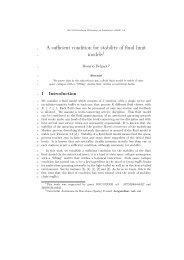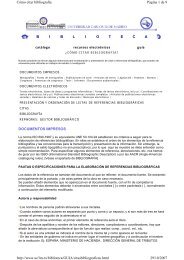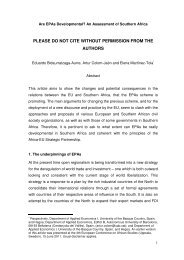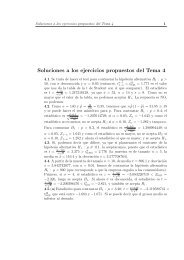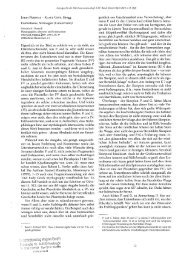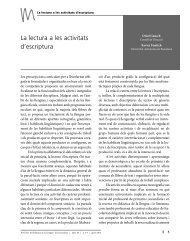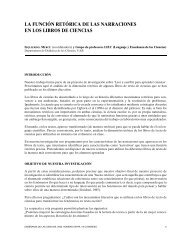J. Theor. Biol. 2006 - PÃ gines de la UAB
J. Theor. Biol. 2006 - PÃ gines de la UAB
J. Theor. Biol. 2006 - PÃ gines de la UAB
- No tags were found...
You also want an ePaper? Increase the reach of your titles
YUMPU automatically turns print PDFs into web optimized ePapers that Google loves.
252<br />
ARTICLE IN PRESS<br />
J.F. Fontanari et al. / Journal of <strong>Theor</strong>etical <strong>Biol</strong>ogy 239 (<strong>2006</strong>) 247–256<br />
linkage of all temp<strong>la</strong>tes on a single chromosome (Maynard<br />
Smith and Szathma´ry, 1993; Santos, 1998). In that sense,<br />
the (partial) failure of group selection is welcome,<br />
otherwise it would be difficult to exp<strong>la</strong>in gene linkage,<br />
and hence the origin of chromosomes, if an arbitrary<br />
number of unlinked temp<strong>la</strong>tes could easily be ma<strong>de</strong> to<br />
coexist within compartments.<br />
To verify how our conclusions are affected by the<br />
assumption that there are a countable infinity of vesicles,<br />
here we carry out a simple Monte-Carlo simu<strong>la</strong>tion to<br />
study the situation in which the number of vesicle is fixed to<br />
a finite value M. Explicitly, we re-interpret Eq. (2) as the<br />
re<strong>la</strong>tive fitness of vesicles composed of k 1 ; k 2 ; ...; k d<br />
temp<strong>la</strong>te types and then use a transition probability<br />
analogous to Eq. (3) to generate the new vesicle popu<strong>la</strong>tion<br />
from the previous one. Essentially, the same stochastic<br />
procedure used to mo<strong>de</strong>l the temp<strong>la</strong>te replication insi<strong>de</strong><br />
each vesicle is used to mo<strong>de</strong>l vesicle replication. The results<br />
for d ¼ 2 <strong>de</strong>generate (s 2 =s 1 ¼ 1) temp<strong>la</strong>tes fenced in M ¼<br />
10; 20 and 40 vesicles of capacity N ¼ 20 are <strong>de</strong>picted in<br />
Fig. 4 together with the analytical result for M !1. The<br />
data represent averages over 100 in<strong>de</strong>pen<strong>de</strong>nt runs. The<br />
point to be noted here is that the behaviour pattern<br />
observed in the case of a finite number of vesicles does not<br />
differ qualitatively from the pattern predicted by the<br />
<strong>de</strong>terministic theory: the sole effect of finite M is to<br />
increase the value of the threshold g c so as to make<br />
coexistence more difficult. As expected, the agreement<br />
between our analytical results and the Monte-Carlo<br />
simu<strong>la</strong>tions improves as M increases and, in particu<strong>la</strong>r,<br />
they become practically indistinguishable for M4500.<br />
Note, however, that by fixing the number of vesicles we<br />
have ruled out the possibility of extinction of the vesicle<br />
popu<strong>la</strong>tion, a realistic ingredient that might pose a serious<br />
obstacle to temp<strong>la</strong>te coexistence when g is set too close to 1.<br />
Nevertheless, our results apply provi<strong>de</strong>d the vesicle<br />
popu<strong>la</strong>tion is not extinct, since then it is likely to be very<br />
<strong>la</strong>rge.<br />
4. The effect of the error tail<br />
The consequences of imperfect replication are catastrophic<br />
for temp<strong>la</strong>tes iso<strong>la</strong>ted in compartments of finite<br />
capacity: even for a vanishing small mutation probability<br />
(u 0) and replication rate (s 0 =s l 0; l ¼ 1; ...; d), the<br />
error tail will be fixed in the compartment. In fact, though<br />
rare, mutations are recurrent and so they will prevent the<br />
fixation of the uncorrupted temp<strong>la</strong>tes. In addition, the<br />
fixation of the error trail is very unlikely to occur because<br />
of its small replication rate, but once it does the game is<br />
over for the uncorrupted temp<strong>la</strong>tes. A possible way out of<br />
this conundrum is to invoke again group selection—the<br />
selection at the vesicle level. The pressing question of how<br />
strong group selection must be in or<strong>de</strong>r to ensure the<br />
survival of temp<strong>la</strong>tes confined in a vesicle is addressed in<br />
this section, where we will concentrate on the interp<strong>la</strong>y<br />
between the group selection pressure and the mutation<br />
probability in the case of d ¼ 1 and 2 temp<strong>la</strong>tes. Since in<br />
the previous section we have shown that introducing<br />
competition between temp<strong>la</strong>tes does not alter qualitatively<br />
the behaviour pattern observed in the case of <strong>de</strong>generate<br />
temp<strong>la</strong>tes, henceforth we will consi<strong>de</strong>r the situation in<br />
which all d uncorrupted temp<strong>la</strong>tes have the same replication<br />
rate, which we set to 1 without loss of generality, while<br />
temp<strong>la</strong>tes in the error tail have replication rate 1 t with<br />
t 2 ½0; 1Š.<br />
First we consi<strong>de</strong>r the case of a single uncorrupted<br />
temp<strong>la</strong>te type (d ¼ 1) in a vesicle of capacity N. Error-tail<br />
temp<strong>la</strong>tes are not inclu<strong>de</strong>d in the initial assignment of<br />
temp<strong>la</strong>tes to vesicles. In Fig. 5, we show the steady-state<br />
frequencies of vesicles with several temp<strong>la</strong>te compositions.<br />
All these frequencies vanish at a critical value of the<br />
1<br />
0.2<br />
0.8<br />
0.15<br />
20<br />
0<br />
0.6<br />
16<br />
Ω 2<br />
0.4<br />
40<br />
20<br />
10<br />
Y<br />
0.1<br />
12<br />
8<br />
4<br />
0.2<br />
0.05<br />
0<br />
0 0.2 0.4 0.6 0.8 1<br />
g<br />
Fig. 4. Fraction of vesicles with two <strong>de</strong>generate types of temp<strong>la</strong>tes in their<br />
composition O 2 as a function of the group selection pressure g for M ¼<br />
10; 20 and 40 vesicles of fixed capacity N ¼ 20. The solid line is the<br />
analytical result for M !1.<br />
0<br />
0 0.05 0.1 0.15 0.2 0.25 0.3<br />
u<br />
Fig. 5. Steady-state frequencies of vesicles with i ¼ 0; 4; 8; 12; 16 and 20<br />
copies of the temp<strong>la</strong>te as a function of the mutation probability u for<br />
d ¼ 1, N ¼ 20, t ¼ 0:1 and g ¼ 0:5. We note that Yð20Þ !1 for u ! 0<br />
and Yð0Þ !1 for u ! u c 0:26.




